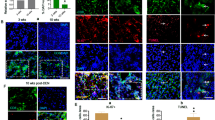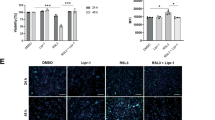Abstract
Tumor necrosis factor-related apoptosis-inducing ligand (TRAIL) has been reported to induce apoptosis in various tumor cells but not in nontransformed, normal cells1,2,3. Preclinical studies in mice and nonhuman primates have shown that administration of TRAIL can induce apoptosis in human tumors, but that no cytotoxicity to normal organs or tissues is found3,4. The susceptibility of tumor cells to TRAIL and an apparent lack of activity in normal cells has lead to a proposal to use TRAIL in cancer therapy. Here, we assessed the sensitivity of hepatocytes from rat, mouse, rhesus monkey and human livers to TRAIL-induced apoptosis. TRAIL induced apoptosis in normal human hepatocytes in culture but not in hepatocytes isolated from the other species. Human hepatocytes showed characteristic features of apoptosis, including cytoplasmic shrinkage, the activation of caspases and DNA fragmentation. Apoptosis and cell death in human hepatocytes was massive and rapid, occurring in more than 60% of the cells exposed to TRAIL within 10 hours. These results indicate that there are species differences in sensitivity to TRAIL, and that substantial liver toxicity might result if TRAIL were used in human cancer therapy.
This is a preview of subscription content, access via your institution
Access options
Subscribe to this journal
Receive 12 print issues and online access
$209.00 per year
only $17.42 per issue
Buy this article
- Purchase on Springer Link
- Instant access to full article PDF
Prices may be subject to local taxes which are calculated during checkout



Similar content being viewed by others
References
Pitti, R.M. et al. Induction of apoptosis by Apo-2 ligand, a new member of the tumor necrosis factor cytokine family. J. Biol. Chem. 271, 12687–12690 (1996).
Wiley, S.R. et al. Identification and characterization of a new member of the TNF family that induces apoptosis. Immunity 3, 673–682 (1995).
Walczak, H. et al. Tumoricidal activity of tumor necrosis factor-related apoptosis-inducing ligand in vivo. Nature Med. 5, 157 –163 (1999).
Ashkenazi, A. et al. Safety and antitumor activity of recombinant soluble Apo2 ligand. J. Clin. Invest. 104, 155– 162 (1999).
Li, P. et al. Cytochrome c and dATP-dependent formation of Apaf-1/caspase-9 complex initiates an apoptotic protease cascade. Cell 91, 479–489 (1997).
Germain, M. et al. Cleavage of automodified Poly(ADP-ribose) polymerase during apoptosis. Evidence for involvement of caspase-7. J. Biol. Chem. 274, 28379–28384 ( 1999).
D'Amours, D., Germain, M., Orth, K., Dixit, V.M. & Poirier, G.G. Proteolysis of poly(ADP-ribose) polymerase by caspase 3: kinetics of cleavage of mono(ADP-ribosyl)ated and DNA-bound substrates . Radiat. Res. 150, 3–10 (1998).
Tang, D. & Kidd, V.J. Cleavage of DFF-45/ICAD by multiple caspases is essential for its function during apoptosis. J. Biol. Chem. 273, 28549–28552 ( 1998).
Pan, G. et al. The receptor for the cytotoxic ligand TRAIL. Science 276, 111–3 ( 1997).
Walczak, H. et al. TRAIL-R2: a novel apoptosis-mediating receptor for TRAIL. Embo. J. 16, 5386–5397 ( 1997).
Pan, G. et al. An antagonist decoy receptor and a death domain-containing receptor for TRAIL. Science 277, 815– 818 (1997).
Sheridan, J.P. et al. Control of TRAIL-induced apoptosis by a family of signaling and decoy receptors. Science 277, 818– 821 (1997).
Degli-Esposti, M.A. et al. Cloning and characterization of TRAIL-R3, a novel member of the emerging TRAIL receptor family. J. Exp. Med. 186 , 1165–1170 (1997).
Pan, G., Ni, J., Yu, G., Wei, Y.F. & Dixit, V.M. TRUNDD, a new member of the TRAIL receptor family that antagonizes TRAIL signalling. FEBS Lett. 424, 41–55 (1998).
Fiers, W. Tumor necrosis factor. Characterization at the molecular, cellular and in vivo level. FEBS Lett. 285, 199– 212 (1991).
Havell, E.A., Fiers, W. & North, R.J. The antitumor function of tumor necrosis factor (TNF), I. Therapeutic action of TNF against an established murine sarcoma is indirect, immunologically dependent, and limited by severe toxicity. J. Exp. Med. 167, 1067–1085 ( 1988).
Tanaka, M., Suda, T., Yatomi, T., Nakamura, N. & Nagata, S. Lethal effect of recombinant human Fas ligand in mice pretreated with Propionibacterium acnes. J. Immunol. 158, 2303–2309 (1997).
Ogasawara, J. et al. Lethal effect of the anti-Fas antibody in mice. Nature 364, 806–809 ( 1993); erratum 365(6446):568 ( 1993).
Strom, S.C. et al. Use of human hepatocytes to study P450 gene induction. Meth. Enzymol. 272, 388–401 (1996).
Strom, S.C., Dorko, K., Thompson, M.T., Pisarov, L.A. & Nussler, A.K. Ilots de Langerhans et Hepatocytes (eds. Franco, D., Boudjema, K. & Varet, B.) 195– 205 (Institut National de la Sante et de la Recherche Medicale, Paris, 1998).
Nussler, A.K. et al. Isolation and characterization of a human hepatic epithelial-like cell line (AKN-1) from a normal liver. In Vitro Cell Dev. Biol. Anim. 35, 190–197 ( 1999).
Seol, D.W. & Billiar, T.R. A caspase-9 variant missing the catalytic site is an endogenous inhibitor of apoptosis. J. Biol. Chem. 274, 2072–2076 ( 1999).
Bohlinger, I. et al. DNA fragmentation in mouse organs during endotoxic shock. Am. J. Pathol. 149, 1381–1393 (1996).
Kothny-Wilkes, G. et al. Interleukin-1 protects transformed keratinocytes from tumor necrosis factor-related apoptosis-inducing ligand. J. Biol. Chem. 273, 29247–53 ( 1998).
Acknowledgements
This work was supported by National Institutes of Health grant NO1-DK-92310 to S.C.S and by RO1-GM-50441 to T.R.B.
Author information
Authors and Affiliations
Corresponding author
Rights and permissions
About this article
Cite this article
Jo, M., Kim, TH., Seol, DW. et al. Apoptosis induced in normal human hepatocytes by tumor necrosis factor-related apoptosis-inducing ligand. Nat Med 6, 564–567 (2000). https://doi.org/10.1038/75045
Received:
Accepted:
Issue Date:
DOI: https://doi.org/10.1038/75045
This article is cited by
-
IL13Rα1 protects against rheumatoid arthritis by combating the apoptotic resistance of fibroblast-like synoviocytes
Arthritis Research & Therapy (2020)
-
Fucoidan protects against subacute diazinon-induced oxidative damage in cardiac, hepatic, and renal tissues
Environmental Science and Pollution Research (2020)
-
Soluble TRAIL Armed Human MSC As Gene Therapy For Pancreatic Cancer
Scientific Reports (2019)
-
Glutamine metabolism regulates FLIP expression and sensitivity to TRAIL in triple-negative breast cancer cells
Cell Death & Disease (2018)
-
Life History Trade-Offs in Tumors
Current Pathobiology Reports (2018)



